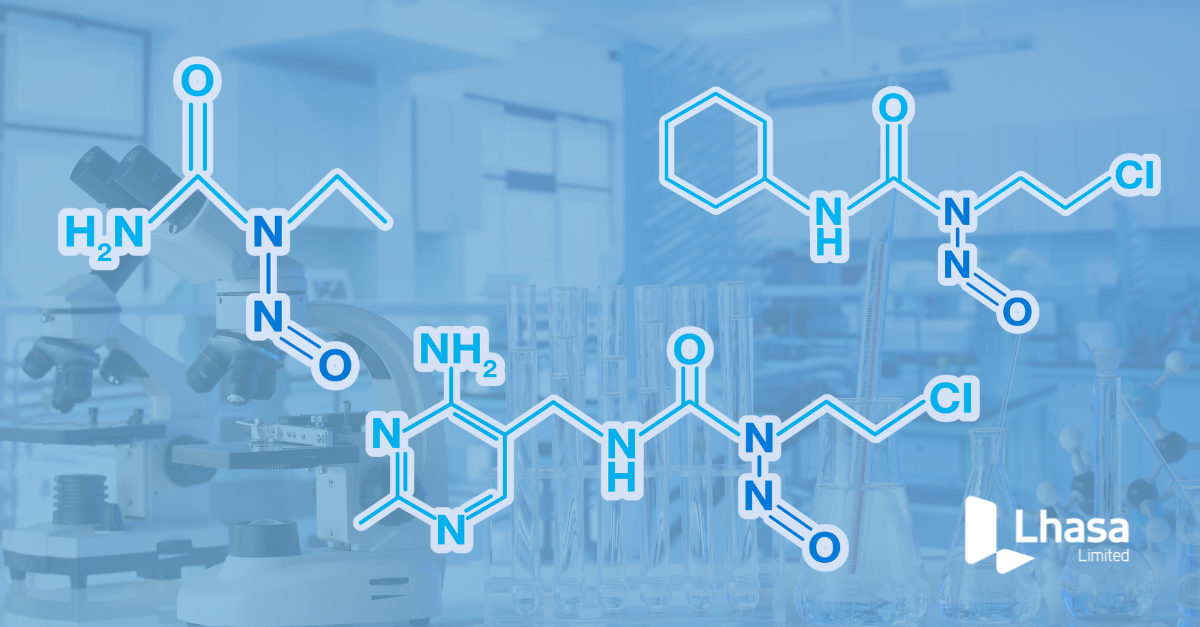Written by Alison Reeves with top tips by Diego Gomes.
Many readers of this blog will be aware of the risk posed by nitrosamine impurities, as an ongoing pharmaceutical industry hot topic.
N-nitrosamines are compounds characterised by a nitroso group bonded to an amine group – nitrosamines are of concern as they can be mutagenic, genotoxic and potentially carcinogenic.
As defined by the FDA: “Nitrosamine impurities may increase the risk of cancer if people are exposed to them above acceptable levels and over long periods of time, but a person taking a drug that contains nitrosamines at, or below, the acceptable daily intake limits every day for 70 years is not expected to have an increased risk of cancer.”
As such, there are now regulations globally which require pharmaceutical organisations to monitor the presence and levels of nitrosamine impurities.
In July 2021 ANVISA published their guidance for assessment and control of potentially carcinogenic nitrosamines in active pharmaceutical ingredients and drug products, guideline nº 50/2021 – version 1 (Guia sobre o Controle de Nitrosaminas em Insumos Farmacêuticos Ativos e Medicamentos, Guia nº 50/2021 – versão 1).
To discuss this topic, we invited Nayrton Flavio Moura Rocha (Regulatory Affairs and Health Surveillance Specialist at ANVISA), Mike Urquhart (Scientific Director at GSK) and Paulo Eliandro da Silva Junior (Regulatory Affairs Analyst at Libbs Farmacêutica) to present within our virtual ‘Lhasa Limited Nitrosamine Impurity Workshop’ alongside Lhasa presenters David Ponting, Rachael Tennant, Michael Burns and Grace Kocks to give their perspectives on this topic.
In case you missed this event, Diego Gomes, Principal Application Scientist here at Lhasa has summarised his top 20 take away points from the workshop for quick and easy consumption:
From a regulatory perspective
- The new guidance from ANVISA for nitrosamines risk assessment, states that a stepwise approach must be conducted. The 3 steps are Risk assessment; confirmatory testing; control of nitrosamines
- Risk assessment must consider reagents and materials, recovery and degradation of materials, cross contamination, manufacturing process and interaction between API, excipients and packing. Also, in situ generation of nitrosamines must be considered, in order to understand the formation and contamination of nitrosamines
- Purge factor calculation (ICH M7 – option 4) is the first strategy that should be evaluated, if appropriate, and a purge ratio is obtained, there is no need for analytical testing if a suitable purge ratio is obtained to use an option 4 control strategy
- Nitrosamine formation can occur in the manufacturing process or during storage. Risk assessment must be carried out to understand the risks at all stages
- For new nitrosamines, the maximum intake should be defined based on carcinogenicity studies, when available. Otherwise, Structure-Activity Relationship (SAR) analysis should be completed.
From an industry perspective
- Guidance notes for nitrosamine assessment best practice consider potential nitrosamines, amine or nitrosating agent sources, process conditions which lead to potential nitrosation (low pH) and the understanding of safety limits for potential nitrosamines
- Consider the impact from packaging. Nitrocellulose can react with amines within printing ink during heating sealing process
- The risk of the portfolio must be classified beforehand, according to the maximum daily dose and duration of treatment
- Understanding the risk of nitrosamines formation can be done by retrosynthesis
- ICH M7 limits and controls strategies apply to nitrosamines. Purge calculation is the first strategy that should be performed, and it can be done with great regulatory acceptance using Mirabilis.
From a Lhasa perspective
- Excellent progress is being made regarding collaborative approaches to support nitrosamine safety assessment. One workgroup is gathering SAR public and donated data, scientifically curating this information, and creating AI/PDE monographs for reference compounds
- Read-across analogues are also allowed by regulatory guidelines, like the ANVISA guideline 50/2021 – version 1, which can be completed by structure similarity and grouping by structural features
- The less than lifetime approach was defended in scientific literature and is permitted in the new ANVISA guideline 50/2021 version 1
- Nitrosamines limits can be raised in 4 situations: Reliable carcinogenicity data, analogue with reliable carc data, less-than-lifetime exposures approach and a robust negative.
- Historical Ames test studies for nitrosamines may not be reliable where they did not follow current OECD 471 guidelines, for example Rao et al. (1979) reported poor sensitivity but only tested up to a relatively low (2 mg) concentration. Retesting of compounds in the Ames assay would be needed. To address this issue, a workgroup collected Ames data, from the public domain, to improve Lhasa’s Vitic and Carcinogenicity Databases. By assessing these databases, it was found that concordance between Ames/Carcinogenicity for nitrosamines is generally very good in comparison to the wider performance, although the OECD guideline has lots of variabilities that may influence sensitivity. The workgroup then defined a protocol to determine appropriate assay conditions within the OECD 471 guideline, for better correlation between mutagenicity and carcinogenicity. By following the protocol, it was concluded that Ames test is highly sensitive for predicting carcinogenicity, and the recommended protocol will be published shortly. Re-testing of Ames negative carcinogenic nitrosamines will be done in future investigations, following OECD standards and the recommended protocol variations.
- The use of purge calculations/ratios has been widely adopted to define the regulatory reporting expectations for purge calculation, with further conservatism built in
- Mirabilis is undergoing development to incorporate a condition approach to better identify the risk of nitrosamines formation. In future, Mirabilis will notify the user where conditions suggest a risk of potentially mutagenic impurity formation, providing details of the risk, and after user input for the impurities to be tracked (justifying the decision), a report is generated, ensuring regulatory confidence
- Zeneth will be updated to incorporate eight types of N-nitroso compounds formation reactions
- Nitrates and nitrites are common nitrosating impurities that can be found in excipients, and therefore the level of risk posed by these impurities needs to be established
- A data sharing initiative driven by Lhasa, in the format of a consortium – Nitrites in Excipients project – aims to gather data from Nitrites in excipients and will allow consortium members to assess the likelihood that a nitrate or nitrite will react to form a nitrosamine through data sharing. The data is hosted in Vitic software, aiming to save time and provide supporting evidence for risk assessments. The consortium discusses the scientific direction of the database, contribute and share expertise and knowledge, being aware of the greater advances in this topic, and also monitor the data to ensure its quality.
For more information about how Lhasa can help with the challenge of nitrosamine assessment and control, please get in touch.
We would love to hear your thoughts on this blog – get in touch with us here.
Last Updated on January 25, 2024 by lhasalimited



